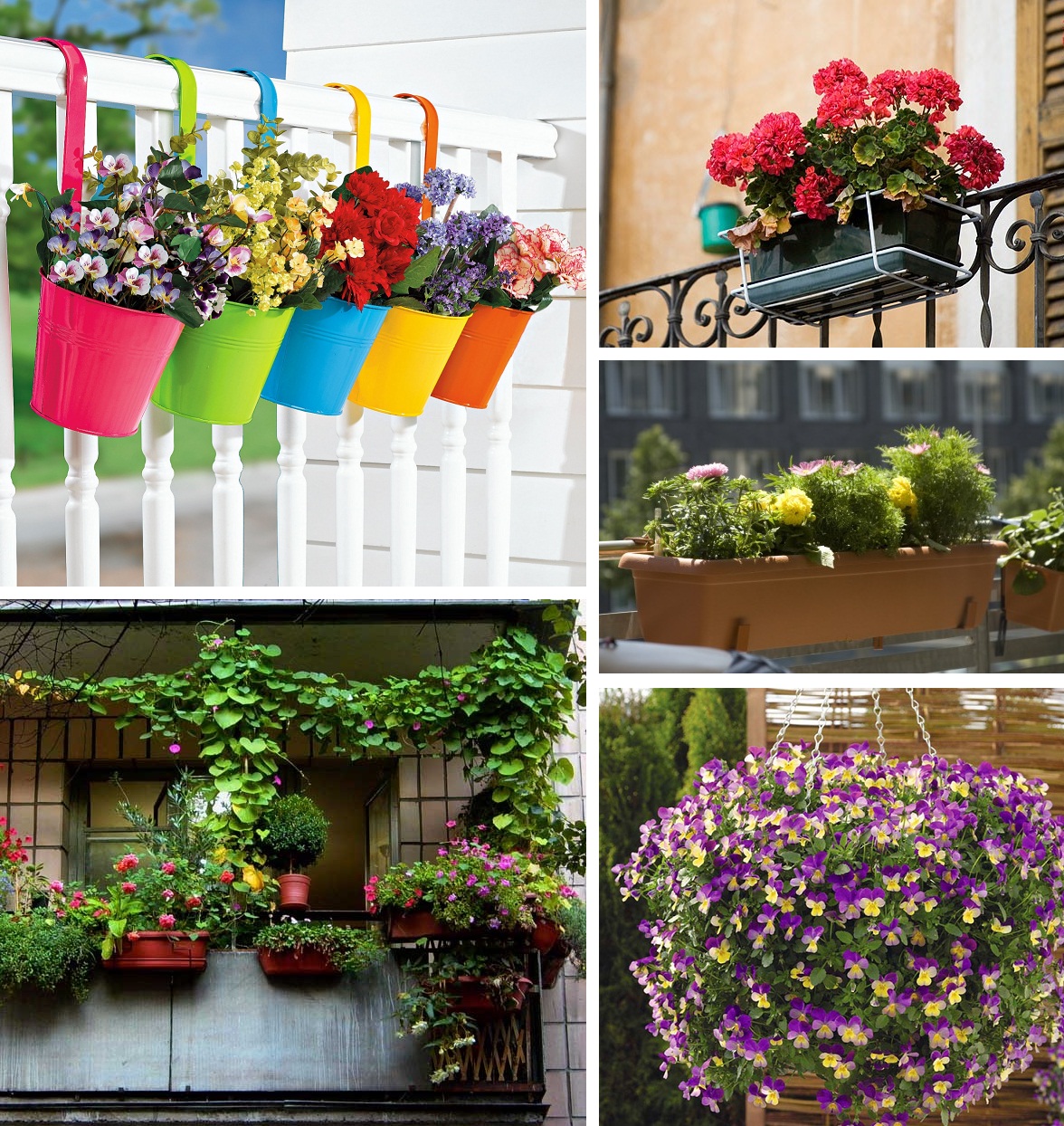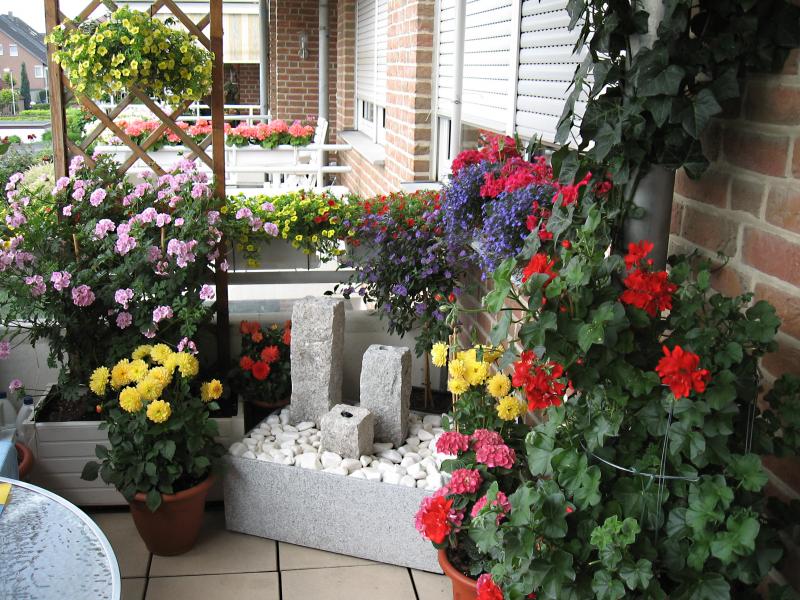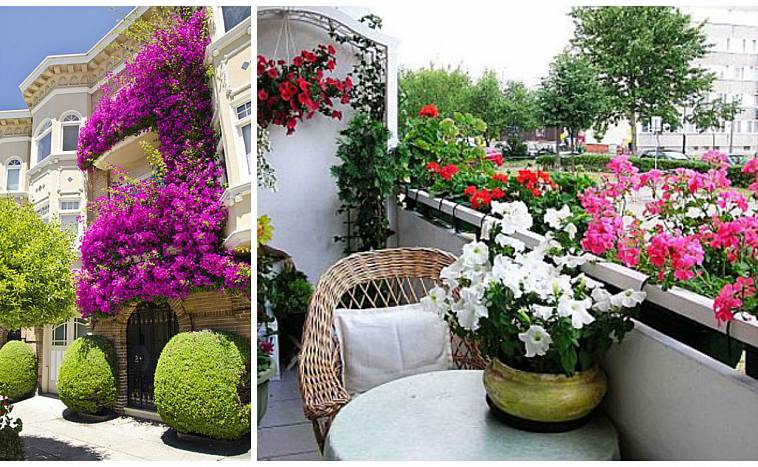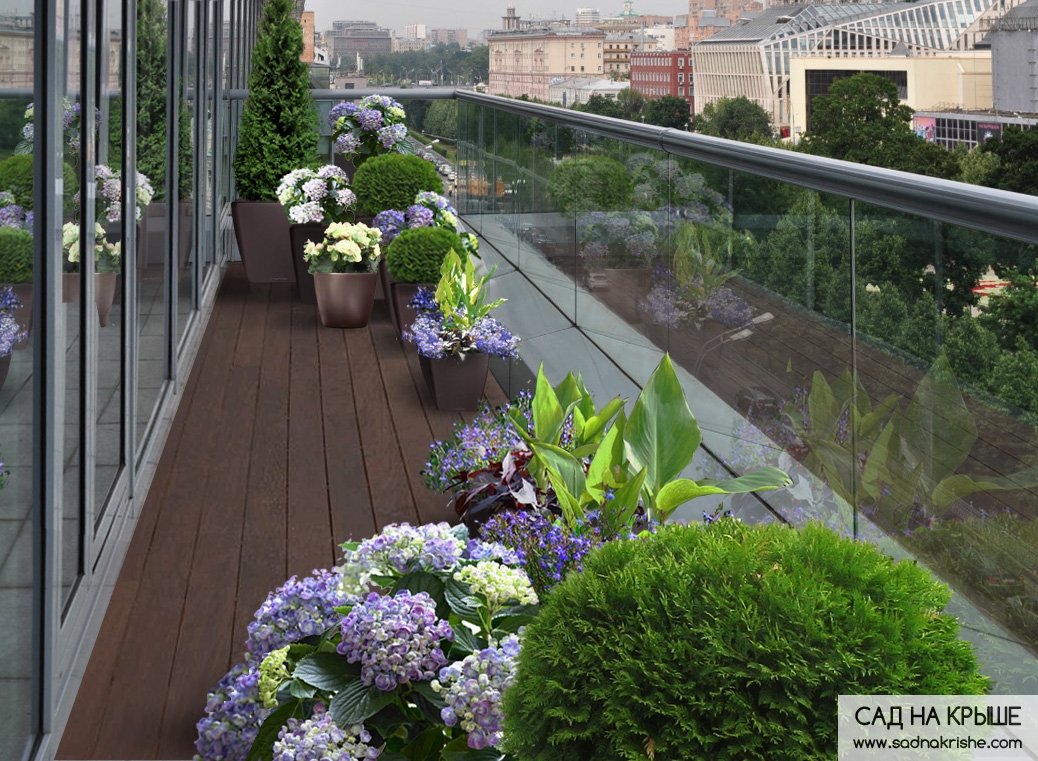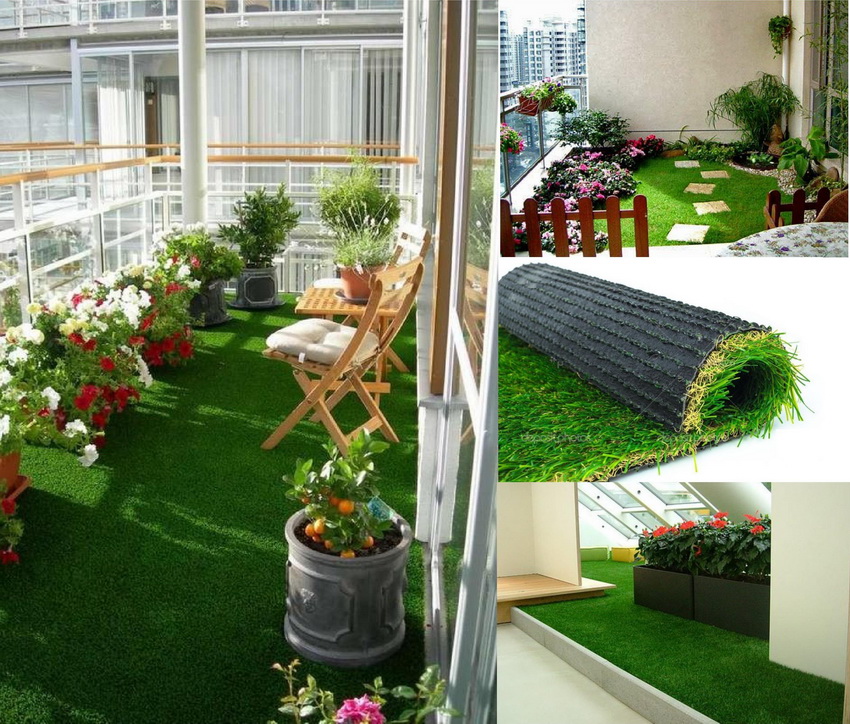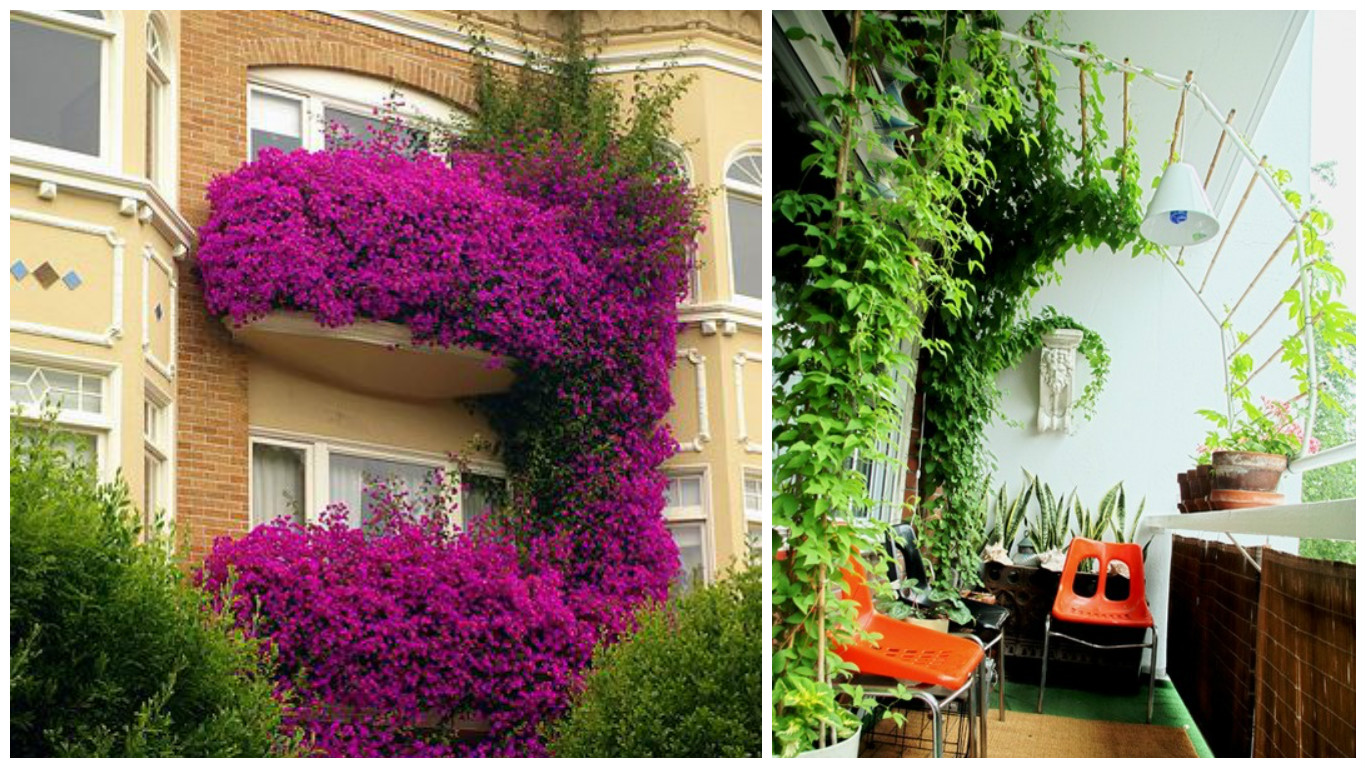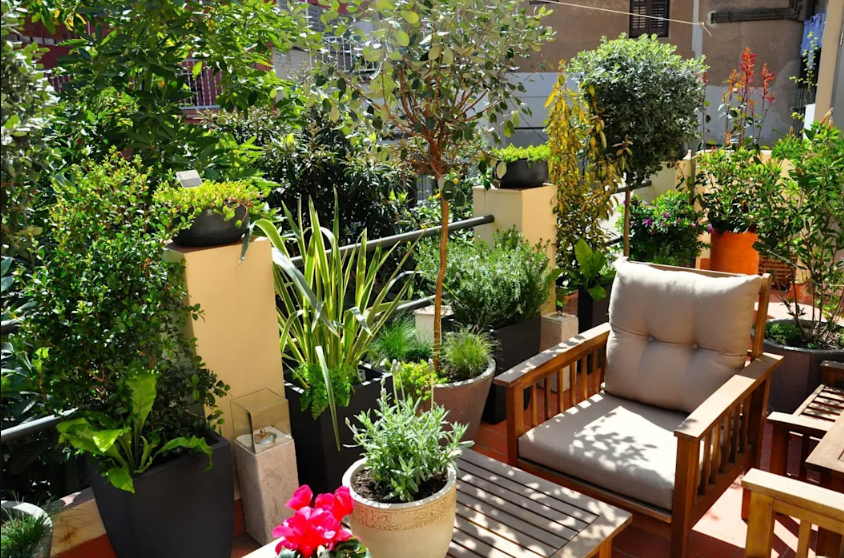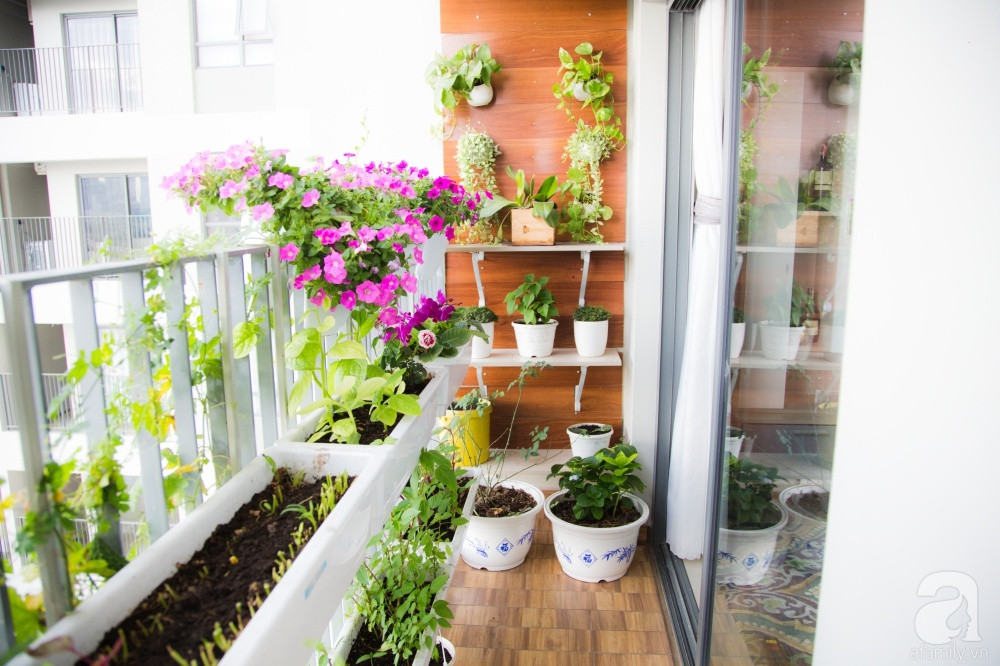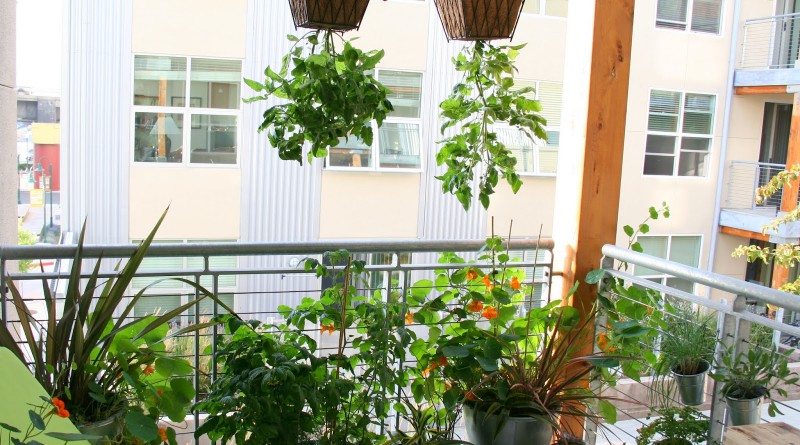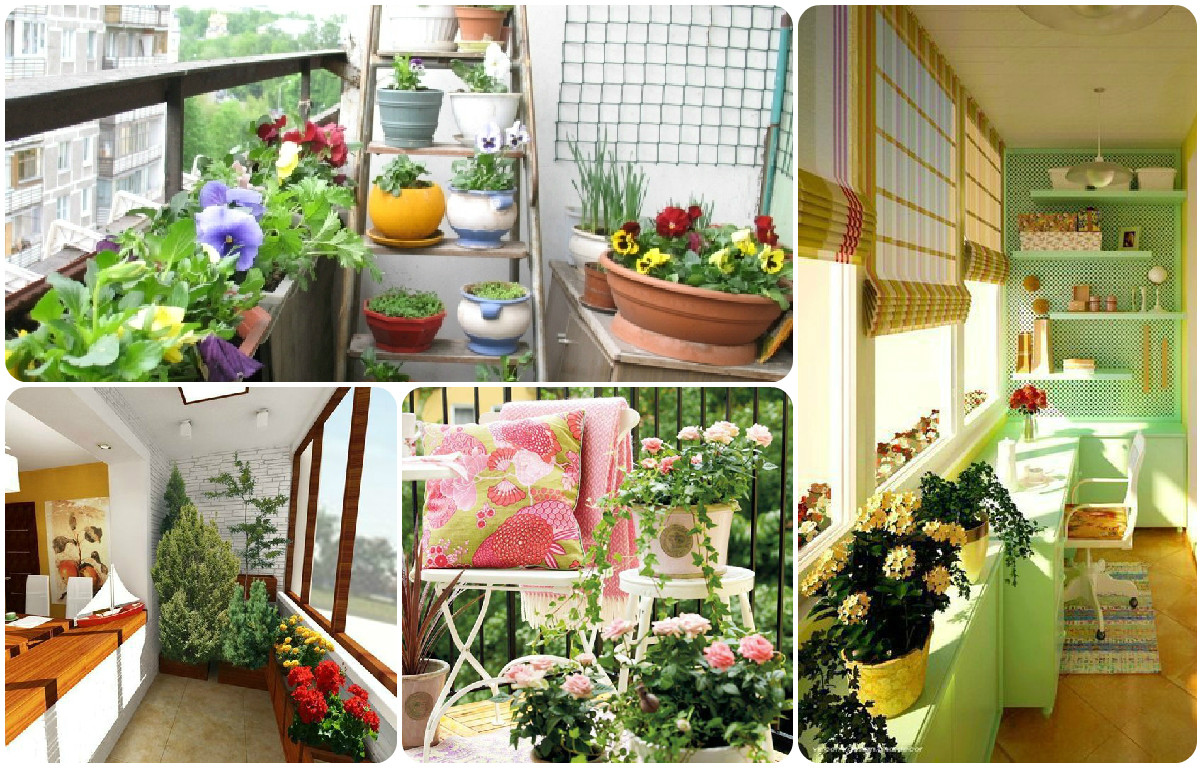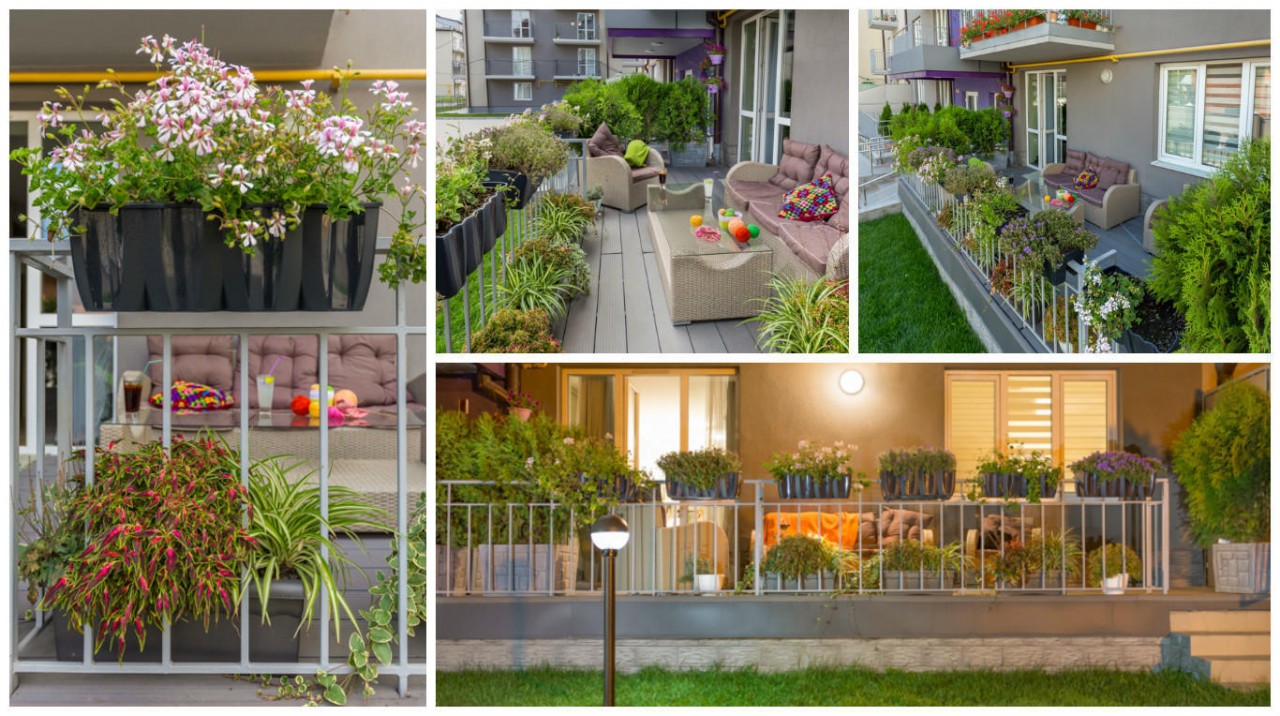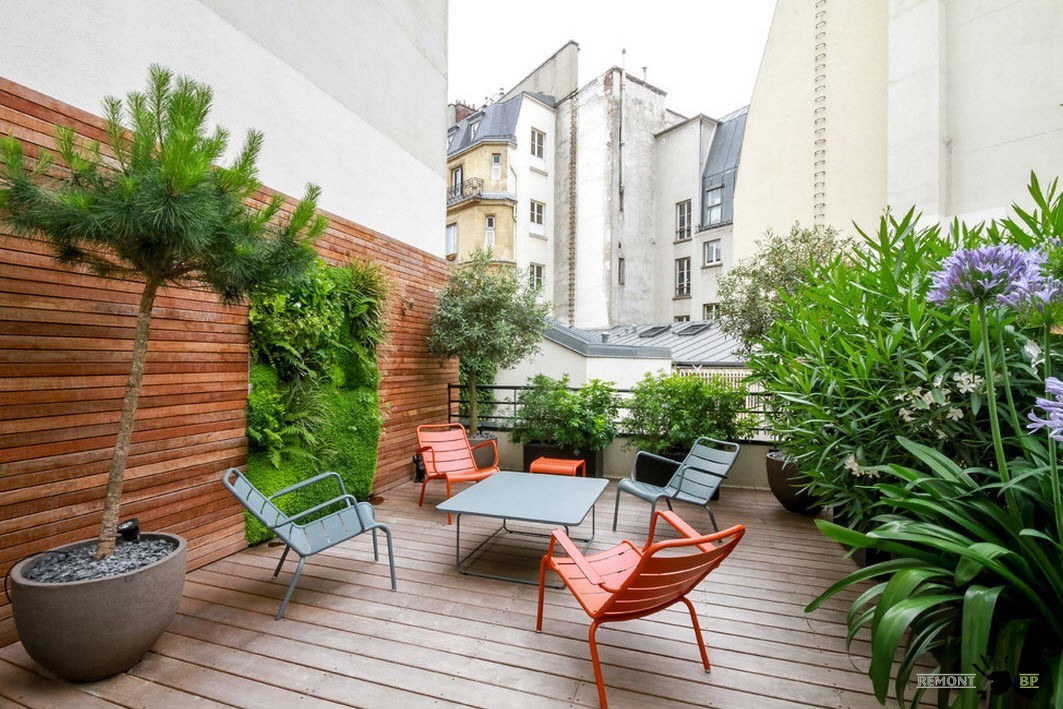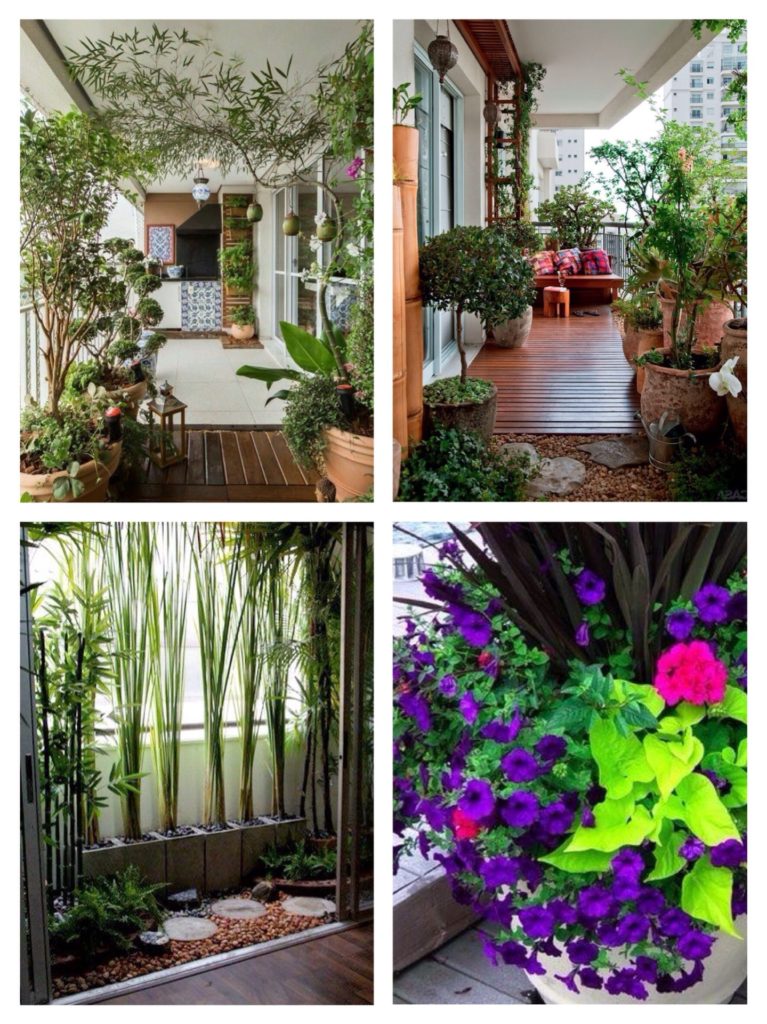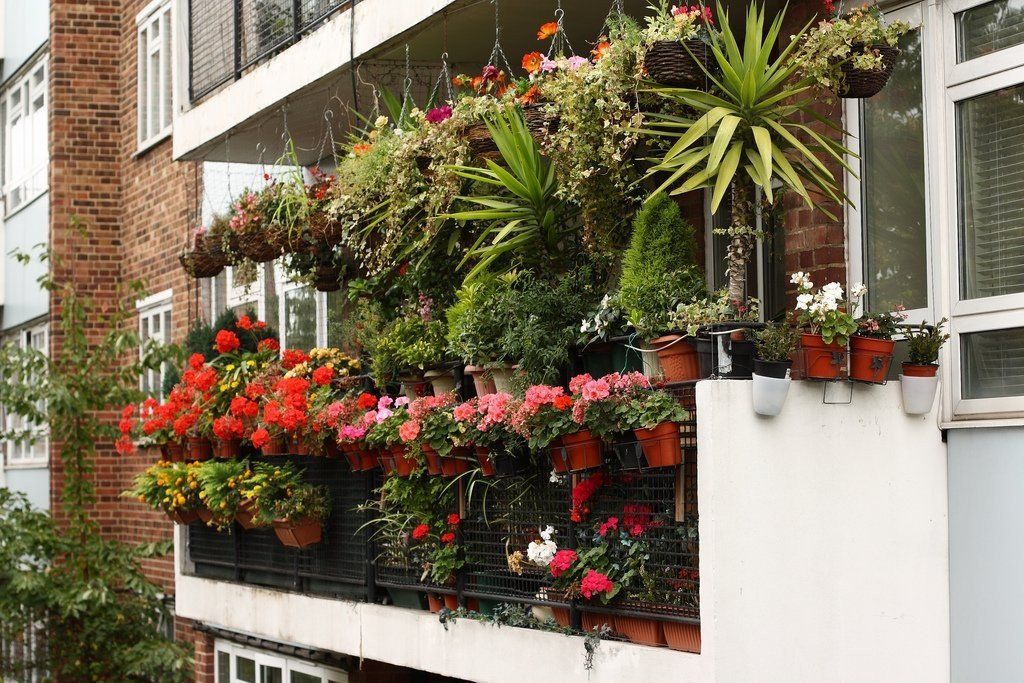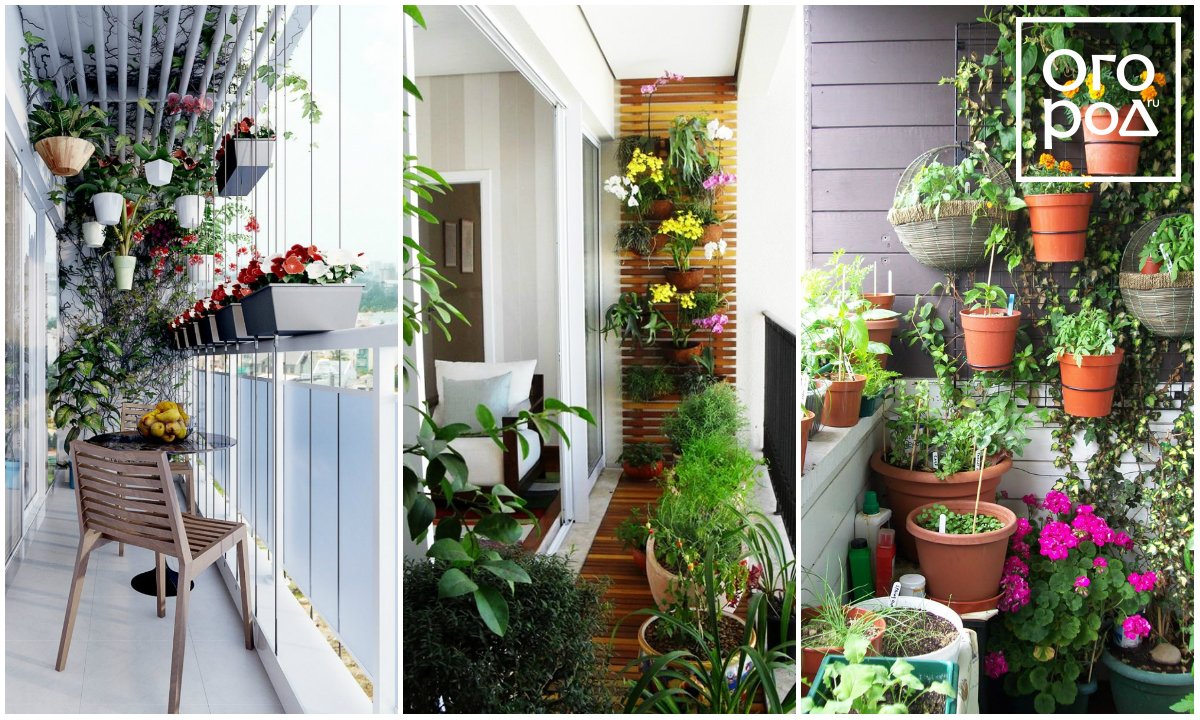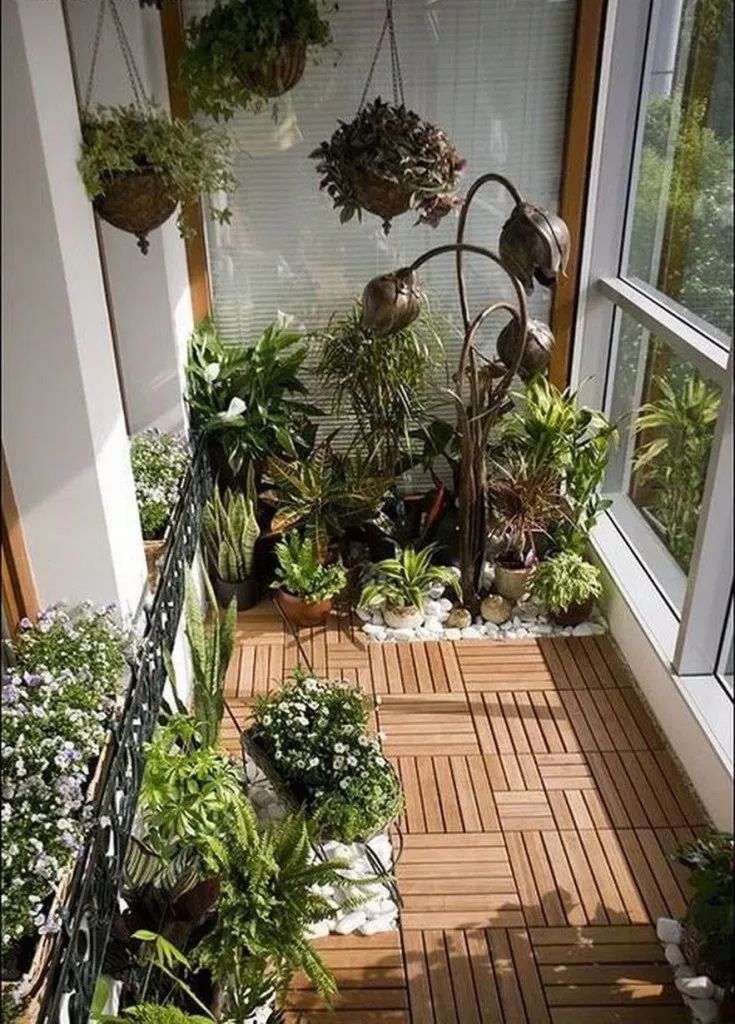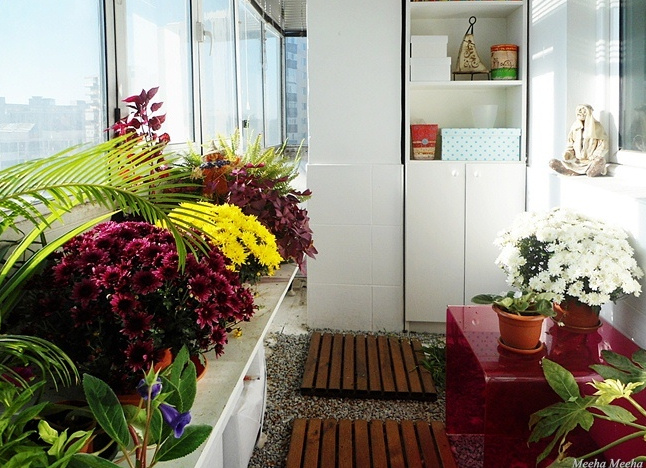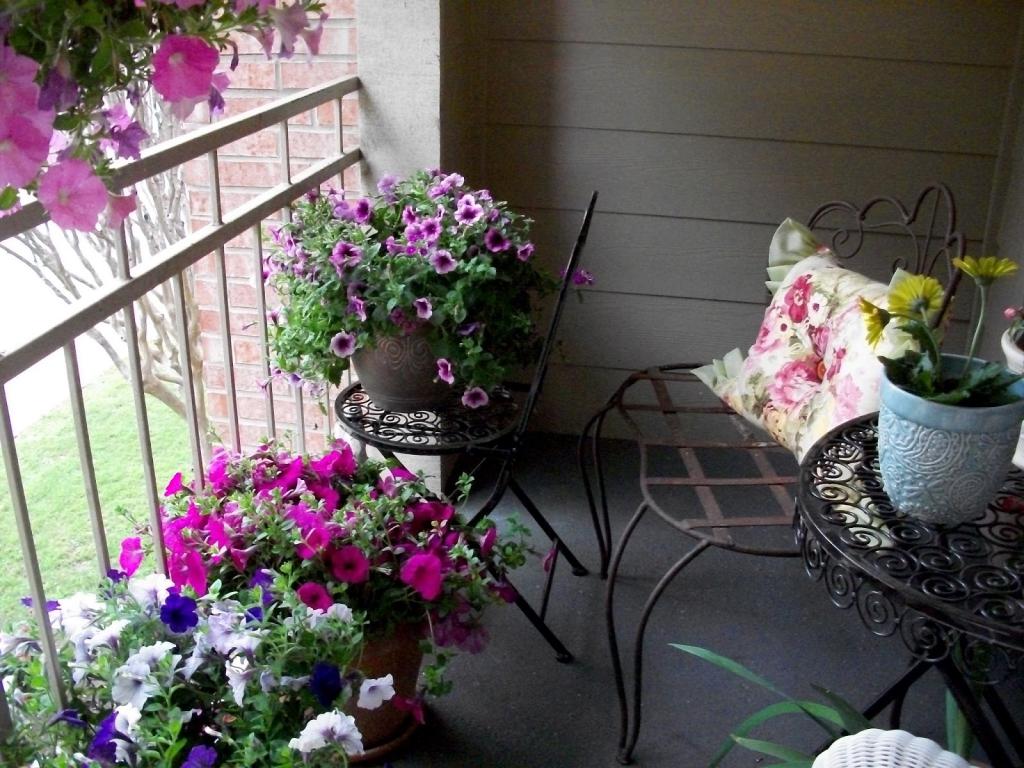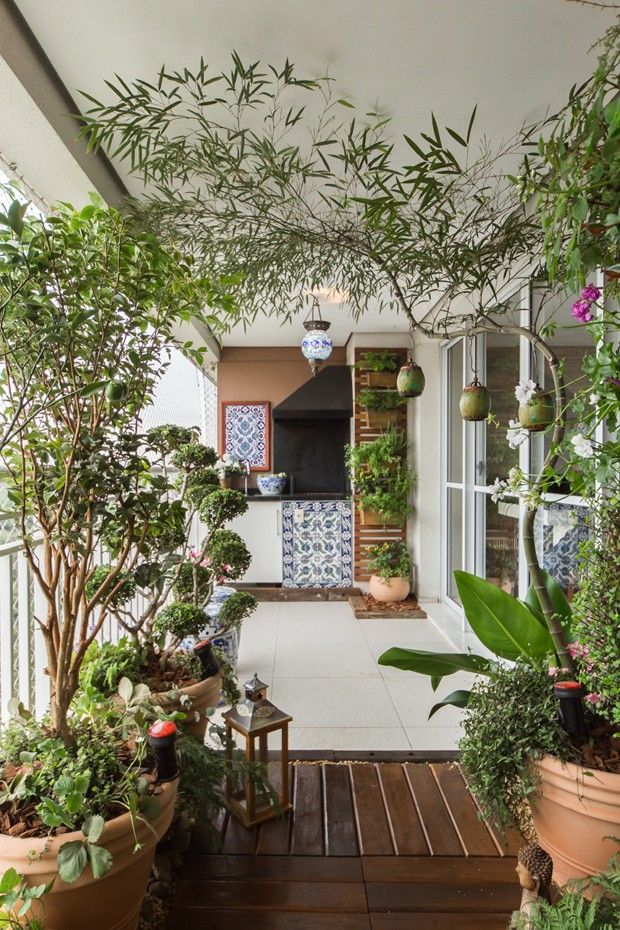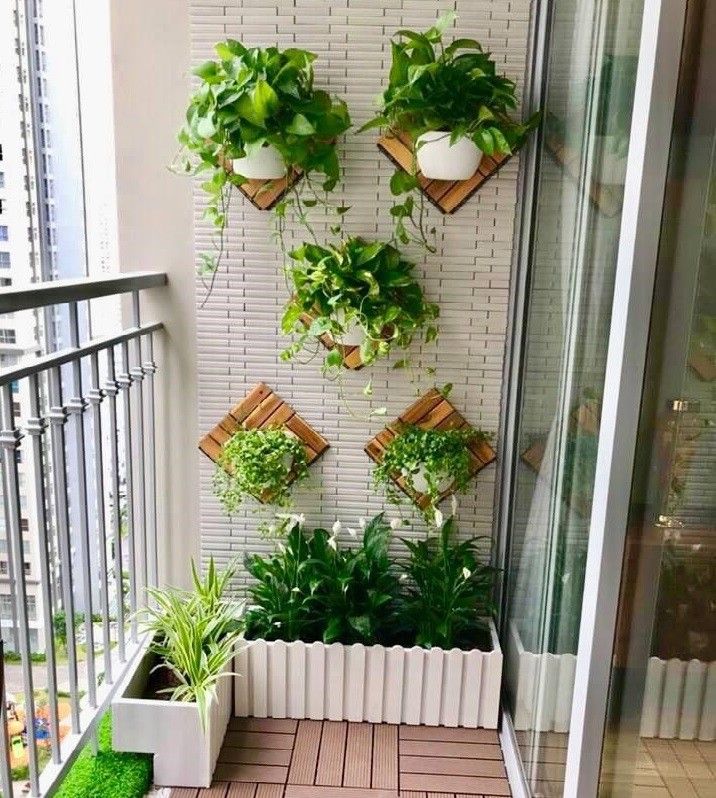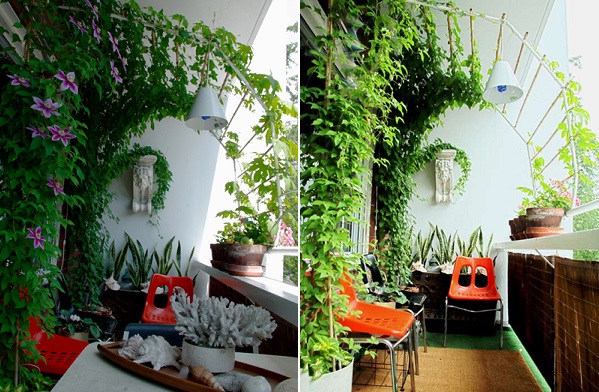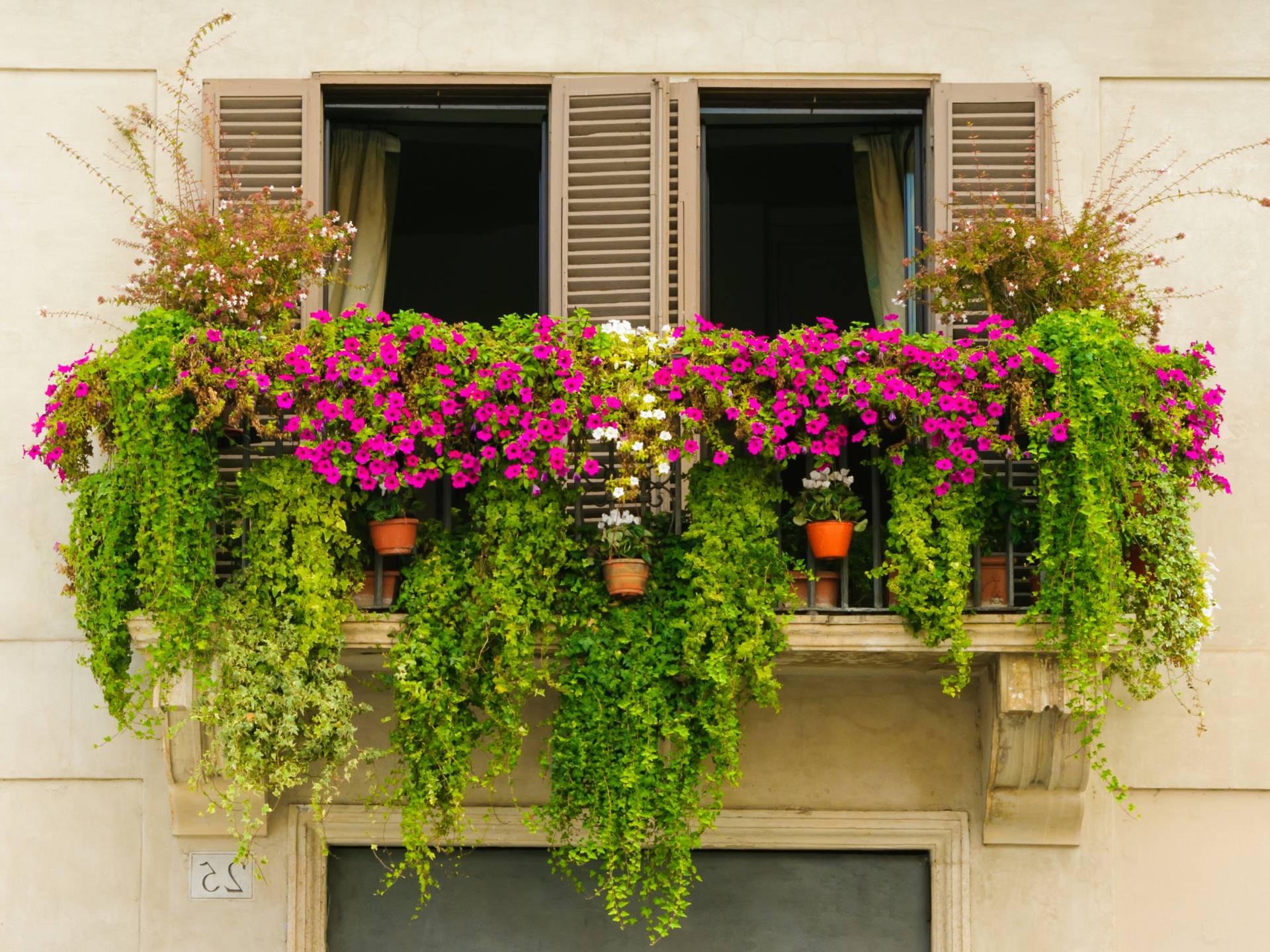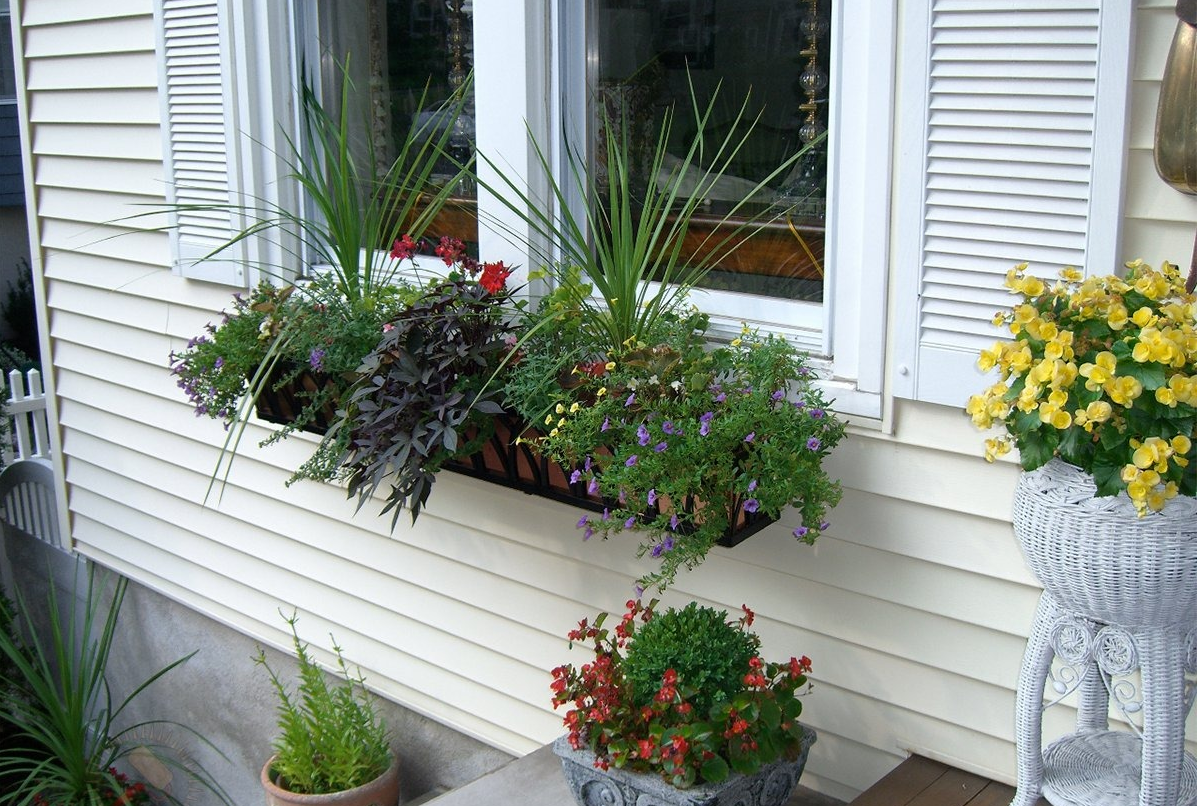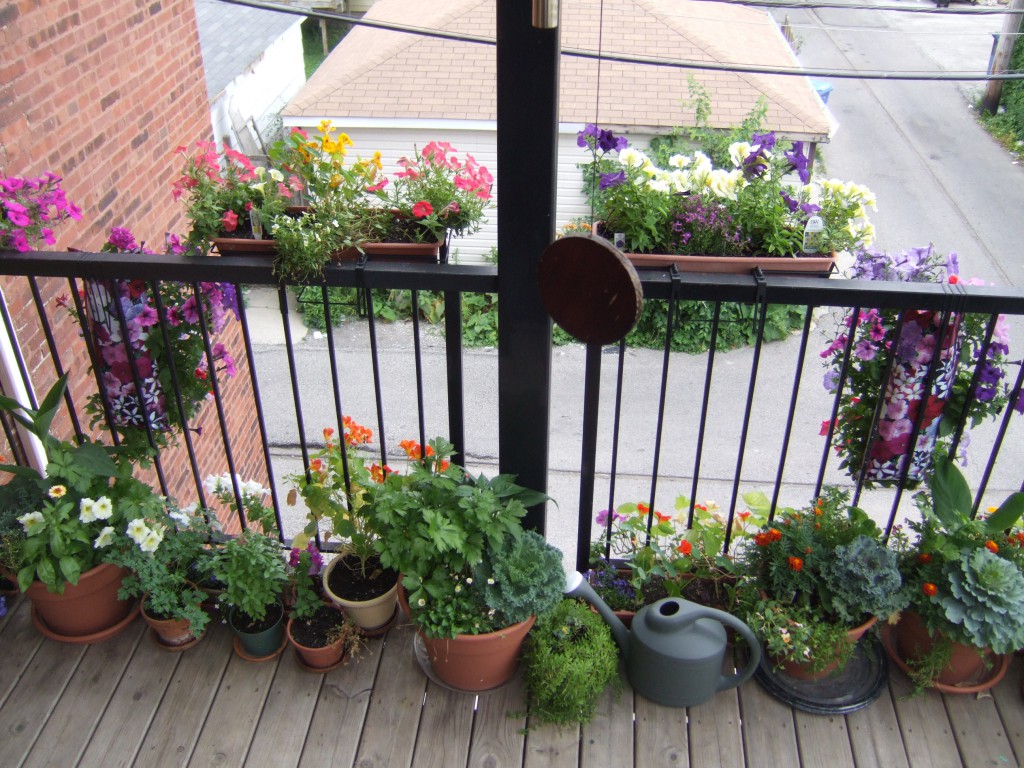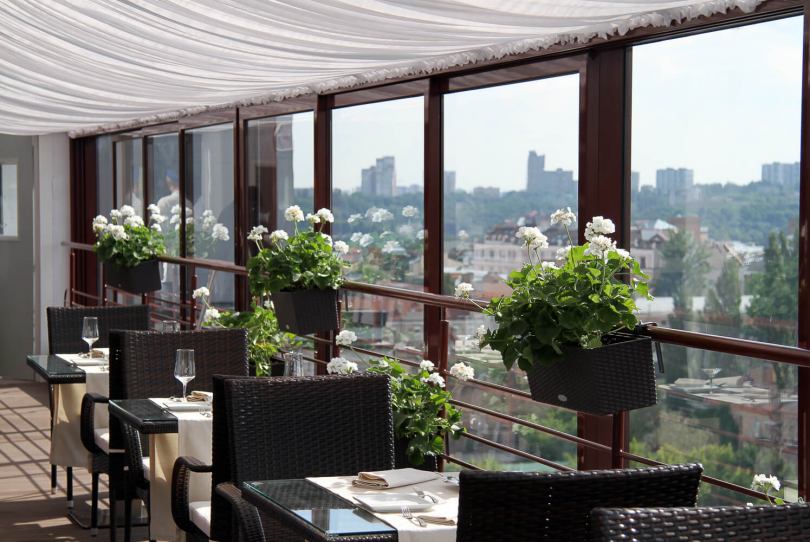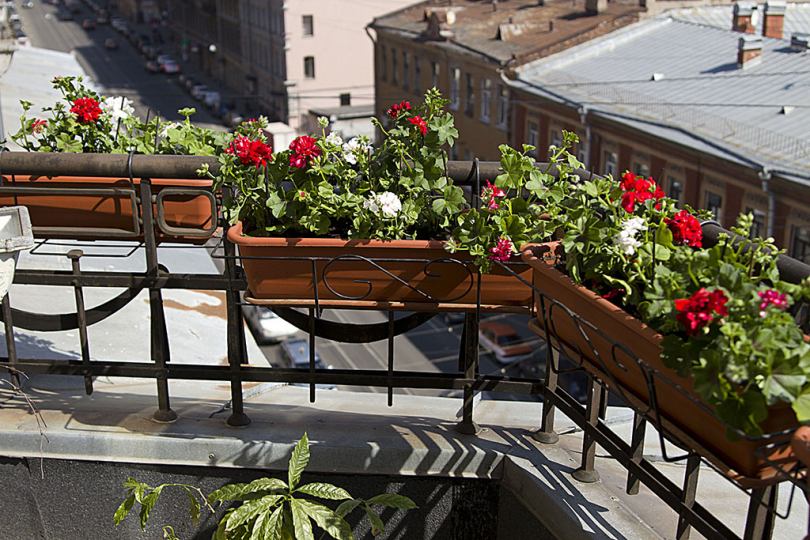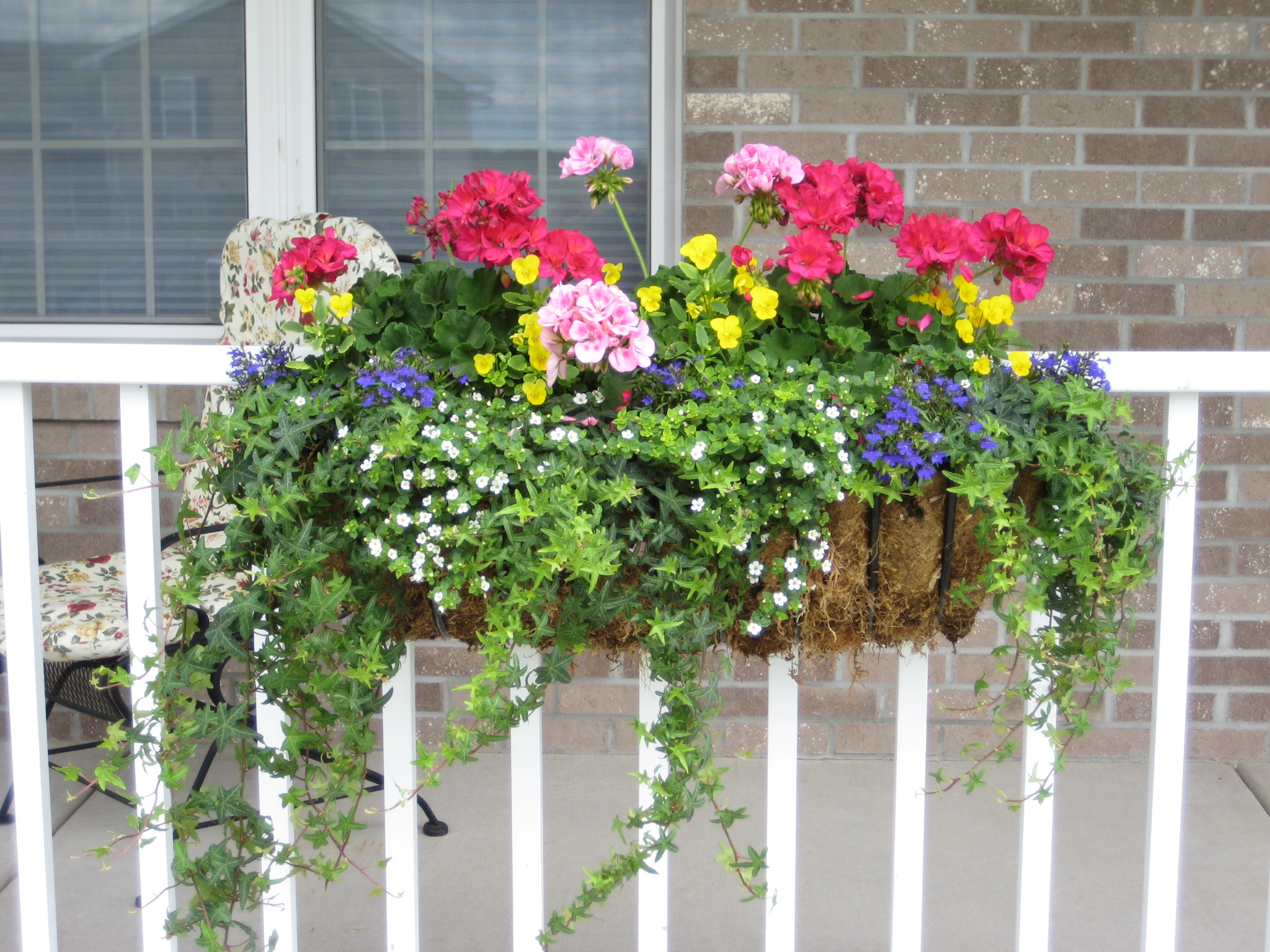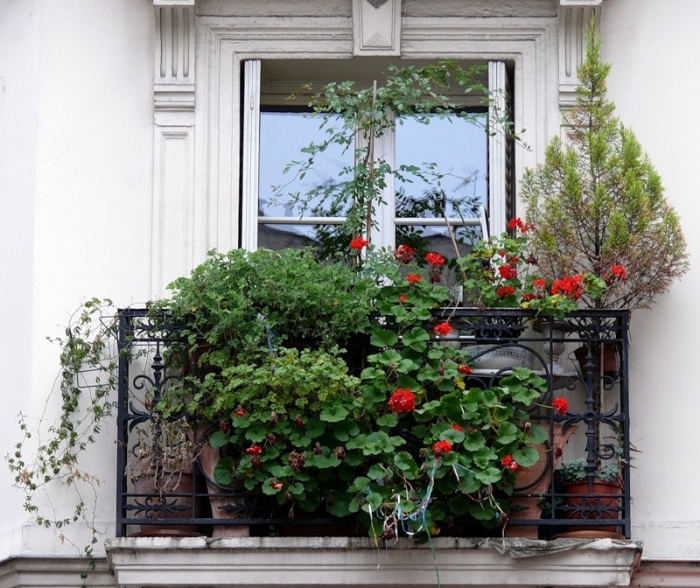Features of vertical gardening of different styles
Before embarking on vertical gardening, you need to carefully consider the design so that reality matches expectations. In general, the work algorithm is as follows:
- Choose a landscaping style. To do this, ask yourself questions: what style suits me best, what exactly I want to decorate (a house, a gazebo or make a phytowall), what scales interest me.
- Think over the appearance of the future design.
- Draw a diagram or order it from a landscape designer.
- Select plants. The choice depends on which design you have chosen. Also evaluate which crops are suitable for your climate, which ones you like externally.
Let's consider the features of different styles.
Landscaping with container plants
To create a vertical flower bed, you can use different inventory:
Hanging planters or regular containers. They are hung from the wall, poles, arbor, etc. As a rule, ampelous flowers are used.
Containers that form a pyramid, or multi-tiered pots. They are installed in a selected area and planted with plants of interest, while you can choose both ordinary flower crops and ampelous ones.
Plastic pipe with holes. The pipe is installed vertically, filled with earth, flowers are planted in the holes.
Mesh-chain-link rolled into a cylinder. The inner walls are covered with polyethylene, the cylinder is filled with soil, cuts are made in the film and flowers are planted.
It is very important that the soil is very nutritious and moisture-consuming. It is necessary to carefully monitor the moisture content of the soil so that the earth does not dry out
And also regularly feed the plants, since they have a limited nutritional area.
Living wall (phytowall)
Fitostena can be in several variations:
Modular type. To create a living wall, it is necessary to install phytomodules - special racks with cells and a drainage system. Phytomodules for vertical gardening are separate elements (like pots) that are fastened after planting.
Carpet gardening. The pocket system involves the use of a cloth (usually felt), which has many pockets for planting plants.
Wooden pallets. Plants peek out between wooden planks.
Vertical gardening with climbing plants
The principle of gardening with climbing plants is extremely simple. You need to plant a seedling next to the selected object (for example, a wall, trellis, arch, pergola, obelisk), the distance between the seedling and the object is 30-50 cm.If the plant needs additional support, then you need to build it in advance (if you want to decorate the wall ) - lattices or strong wire on hooks, netting netting, wooden netting. After planting, you need to take care of the plant and, as soon as it grows up, fix it to the support (if they do not attach on their own).
Structures for climbing plants
Most often, with vertical gardening, vines grow on the wall. However, it is also popular to grow on special structures - supports for climbing plants.
The most popular and interesting options for supports for vines:
Gazebos;
Pergolas;
Arches;
Tapestries;
Bersot.
Secret 2: Playing on Contrasts
Agree, pots of the same color and size, lined up in one row, look "neat, but poor." To make the composition harmonious, effective, not boring, it is worth learning to play not only with color, but also with shape.
How can this be achieved? For example, use containers of the same color, but different shapes and sizes.When put together, they will look very stylish even if you fill them with plants of the same species.
In bright, unusual containers, plant more modest decorative leafy plants: hosts, coleus, ferns, etc.
In simple plain pots, you can plant catchy bulbs or any other bright flowers.
Fuchsia
Evergreen ampelous fuchsias for the full development of a small amount of light and coolness. Direct sunlight is destructive for them: the flowers may not open or are crushed. Therefore, the plants will like it on the northern balcony. Fuchsia flowers are very unusual, they resemble skirts. The stamens are long, with sweet nectar. A very elegant and unpretentious plant!
How to care for fuchsia on the balcony
The flower does not like drought, as soon as the earth dries up, the plant immediately dies, so water the fuchsia regularly and abundantly. But make sure that no water stagnates in the pot. In addition to watering, fuchsia also needs regular feeding and pruning. Young plants need more nitrogen, and fertilize the grown shoots with phosphorus and potassium, then the buds will cover the entire bush and bloom magnificently. Prune side shoots to create a beautiful crown.
The main pest of the plant is the whitefly, the larvae of which feed on the cell sap. But on the northern balcony, most likely, they will not disturb the fuchsia, because love warmth. For a lush bloom, transplant the flower into a spacious container annually.
Viola
Bright viols, or pansies, are found in almost every garden. But you can successfully grow this flower on the balcony. Viola is completely unpretentious and will delight with flowering until autumn. Usually it is planted on sunny balconies, but there pansies can suffer from the heat. Therefore, the northern one is quite a good alternative.
And if the sun gets on your balcony at least occasionally, pansies will bloom much longer than if they grew in bright light.
Be prepared for the fact that when planted in the shade, the viola will bloom smaller and slightly paler than when grown in the sun.
How to care for a viola
Viola loves light and loose soil. Water the soil as soon as it dries out a little. Moderate watering will help avoid rot, which affects the delicate roots of the viola. To achieve flowering, feed the flower weekly with complex fertilizers, inspect it from pests. And once every 10 days, loosen the soil so that a dry crust does not form on the surface. When planting seedlings, leave at least 15-20 cm between the plants so that the roots feel comfortable.
What flowers to plant
Verbena ampelous:
- leaves are dense, hairy;
- color of flowers - blue, purple, pink, red.
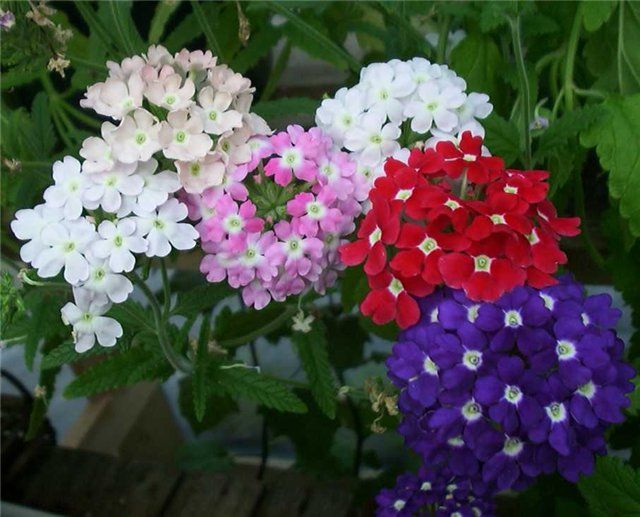
Variety of Verbena colors.
This plant attracts butterflies and, according to ancient legend, serves as a talisman against ill-wishers.
Lubelia ampelous: small oblong leaves are practically invisible from under the abundant cap of flowers.
Flower color:
- blue;
- blue;
- purple.
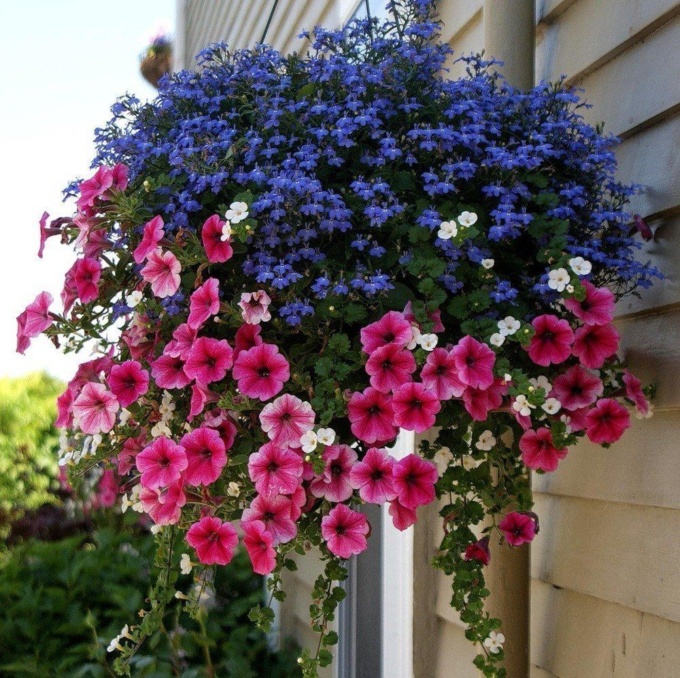
The breeders have not yet bred the red lubelia! Don't trust adventurous negligent sellers!
Diascia:
- leaves are opposite;
- dark green (glossy);
- color of flowers - purple, salmon, orange, pink.

Their diameter reaches 20 cm. Shoots grow 30-50 cm, depending on the variety.
Fuchsia ampelous: flowing stems, decorated with flowers of white-pink, scarlet or lilac-purple color.

The flower reacts sensitively to a change in location, so it is advisable to immediately place a basket or pots with fuchsia in a permanent place.
Moorish Bindweed: Blooms in all shades of blue all summer without interruption. It is absolutely unpretentious to the soil.

With proper care, flowering lasts until the first frost.
Scovola's lanceolate leaves are large enough (up to 9 cm);
Flower color:
- blue-purple;
- lilac;
- blue;
- White.

By the shape of the flower, all the petals are asymmetrically concentrated on one side of the tube and form a kind of fan.
Ampel petunias: beautifully flowing lashes reach 80 cm.
Such plant varieties as "Snow Queen", "Double Cascade", "Ramblin" have a pleasant aroma. Such a variety of petunias as "Black Velvet" is beautiful and unusual. We wrote more about petunias here.
The petals of a stunning deep black appear velvety and form a flower with a diameter of 8-9 cm.
Ampel fern: openwork leaves need regular spraying. The leaves can be up to 80 cm wide.
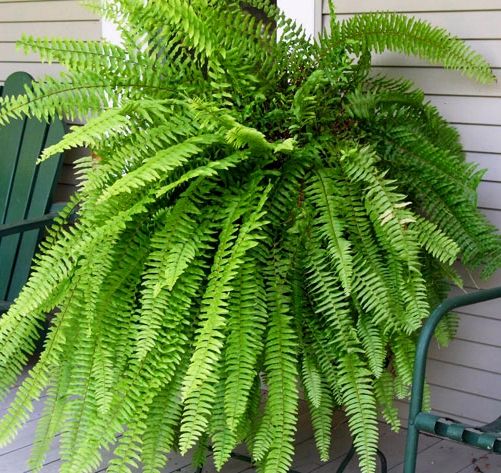
Prefers acidic soil.
Ampel begonia (Begonia Limminga): hanging shoots of the plant reach 30-50 cm Leaves are light green with a yellowish tinge.
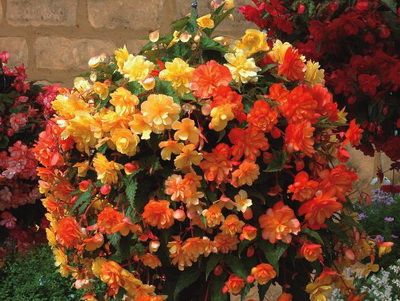
The color of the flowers ranges from light red to coral.
What plants will do well on the balconies on the north side
On the northern side of the buildings, there is a lack of lighting, which some plants cannot stand. Here, for landscaping balconies, you should select flowers with great care. The following plants tolerate shading normally:
Fuchsia - you should not hope for its abundant flowering on the northern balconies. However, the plant intensively grows green mass and forms a lush bush. The main thing is to organize regular watering, preventing the soil from drying out.
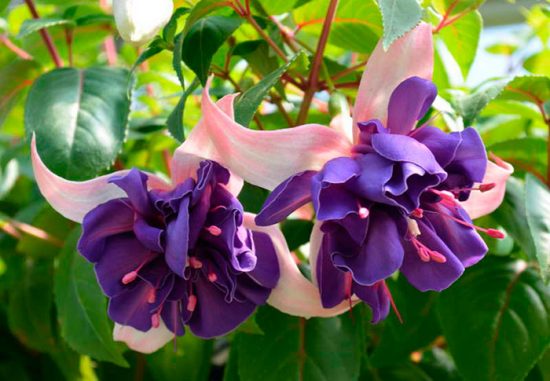 Fuchsia
Fuchsia
- Mimulus - thanks to the extended forward petals, the people call him "lipstick". The plant feels great in the shade and has a fast growing season - it takes about two months from the moment of sowing to flowering.
- Calceolaria is a very interesting shade-tolerant plant with yellow, brown speckled flowers. The leaves do not tolerate water ingress, so the plant is best grown on glazed balconies and watered very carefully.
- Waller's balsam is a plant with thick, fleshy stems and flowers of various colors. At the slightest frost, it dies, so it is planted on open balconies as late as possible.
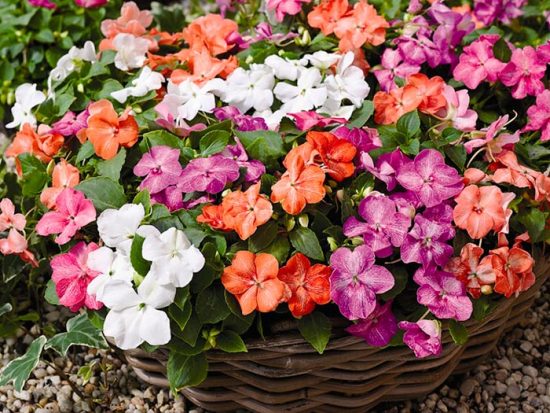 Waller's balsam
Waller's balsam
- Marigolds - these flowers are striking in their variety. There are high, medium and low varieties. It is better to place the former on the floor of the balcony, and the latter on the sides of its fences. Plants bloom from summer to late autumn.
- Periwinkle is an evergreen perennial. Its creeping stems are covered with delicate blue flowers in May. Dark green glossy leaves can decorate the balcony all year round.
- Fragrant tobacco - the plant is a close relative of petunia, but it tolerates shading absolutely normal.
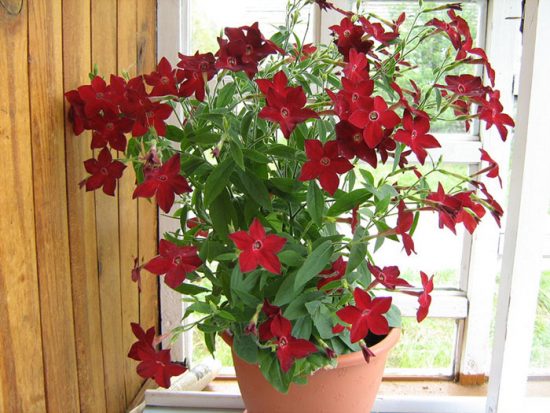 Scented tobacco
Scented tobacco
The same flowers can be used for landscaping the balconies that are located on the west side of the house.
Plant container options
Containers for flowers will help to achieve harmony in design. In this capacity are pots, pots and boxes. Plastic molds successfully combine strength and lightness, so they are optimal for flowers located on an external fence. When planting flowers on the outside of the balcony, it is recommended to abandon long boxes, it is better to use several forms up to 1 meter long.

Clay pots should preferably be placed on the floor due to their weight. Before the first use, they are immersed in water for a couple of hours. Due to the displaced air bubbles, this procedure will increase the strength of the product. It is advisable to choose dishes for flowers with small holes in the bottom and the presence of a pallet so that the excess moisture that comes out does not spoil the design of the balcony.
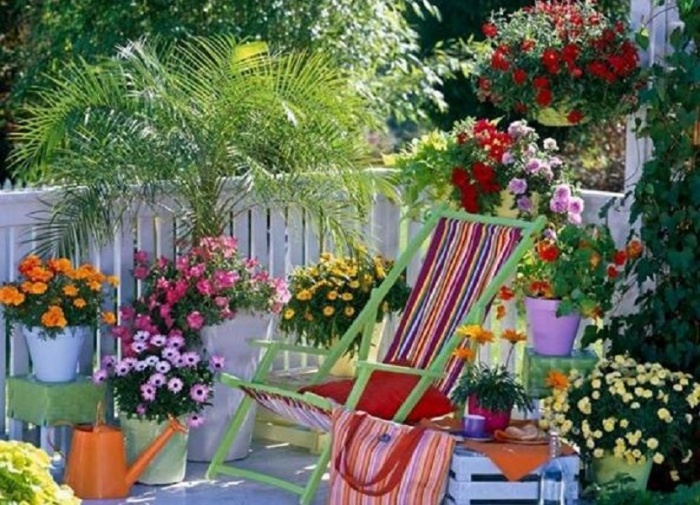
Even if in the first year the design of the balcony does not correspond to the idea of beauty, do not despair. The experience will come with time, and the balcony oasis will win the hearts of passers-by.
Balcony garden concept
If you are going to take 3-5 flower pots to the balcony, you can simply place them in the most suitable places. Are there many more flowers? Then you need to carefully think over the concept of the garden and develop its design.
One of the possible options is imitation of a terrace. Suitable for open spaces not limited by the glazing structure. Use flowerpots, floor boxes, hanging planters. Decorate the walls with ampel flowers. For completeness, use streetlights (or imitation) and lightweight folding furniture.
Tropical garden. Suitable for a carefully designed balcony. Important: long daylight hours, high humidity, regular watering. Use large deciduous and flowering perennials. It is better if their buds are single, but large and bright.

Large palm species "plunge" into the tropics
The garden of one plant is a rose garden or orchidarium, where only roses or orchids grow, respectively. Requires careful maintenance and constant monitoring of the room microclimate. However, all efforts will more than pay off with a luxurious bloom.
For those looking to save time, the concept of a natural garden is the way to go. For him, it is better to use garden plants, both ampelous and erect. Let them grow freely without giving the bushes a clear shape. Ampelny can only be directed in the desired direction with the help of special supports. Such a garden will be decorated with large dry tree branches, small stumps and even stones.
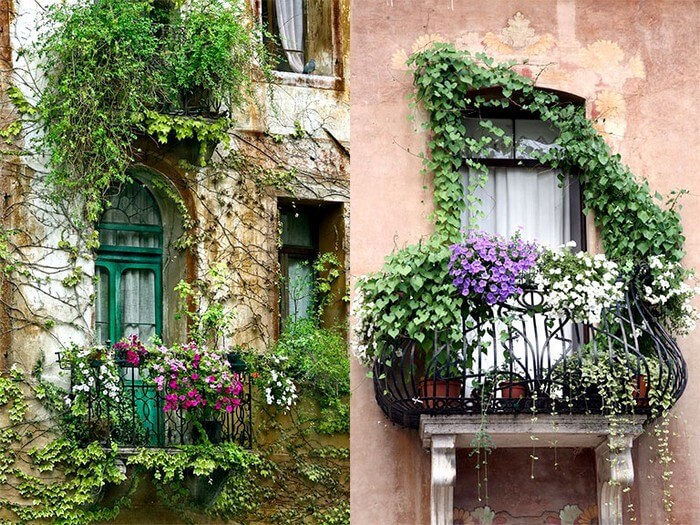
The idea of a natural garden is best realized on an open balcony.
If you prefer flowering species, then you can choose them so that all flowers have the same shade or contrast favorably. A bright solution is a combination of yellow, orange and red buds, a classic one is a combination of any shade with white.
The choice of plants, taking into account light-requiring
Depending on the location of the structure, they can be either brightly lit or shaded.
In this case, the position to the cardinal points is not important. Even the south facing loggia can be shaded.
Shadows come from nearby houses, nearby trees, and other objects. Before planting plants, you should evaluate the amount of light falling on the balcony space.
Plants for illuminated balconies
If the balcony space is well lit, then most of the plants are suitable for growing. These can be annuals. There are a lot of varieties and colors of petunias. This flower is easy to care for, blooms for a long time and abundantly.
In addition to the classic varieties, ampelous and bush petunias are now bred. By the size of the flower, they are large-flowered and small-flowered, and by the nature of the petals, they are ordinary and double. The color of petunias is not only monochromatic. In some flowers, there are combinations of shades.
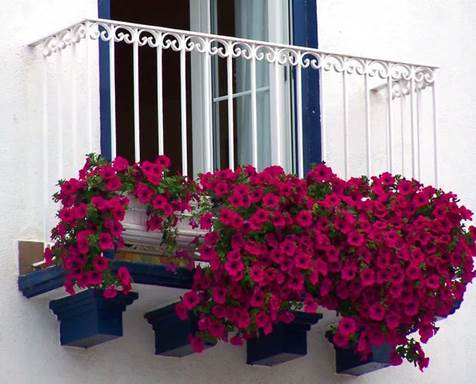 Rice. 5 Plants for the balcony - petunia
Rice. 5 Plants for the balcony - petunia
Another plant that is great for loggias is marigolds. There are also a huge number of varieties of marigolds. They are distinguished by the color of the inflorescences, which ranges from red or orange to white.
Marigolds are drought-resistant, which is especially true on balconies with bright lighting. They grow quickly and bloom in a short time.
In order for the plants to continue to bloom actively, it is important to cut off the already withered inflorescences. Otherwise, the food will go to the ripening of the seeds.
If you want to choose which flowers to plant on the balconies so that they bloom all summer, then marigolds are one of the most successful options. With their help, you can create an original design.
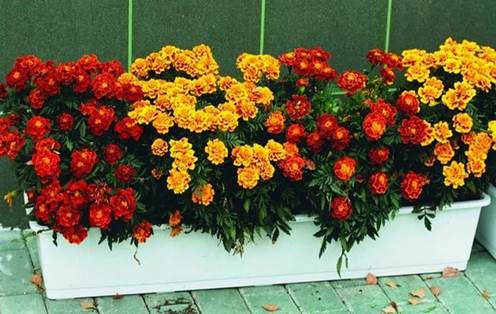 Rice. 6 Flowers for the balcony on the sunny side - marigold
Rice. 6 Flowers for the balcony on the sunny side - marigold
Low-growing varieties of plants look best on loggias. You can plant asters, small dahlias, calendula, snapdragon, nasturtium, and balsam. Many herbs do well in containers. You can often find a purslane on balconies.
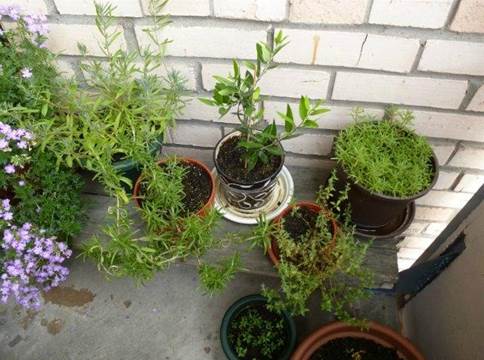 Rice. 7 Spicy herbs will complement the design
Rice. 7 Spicy herbs will complement the design
Sweet peas, ornamental beans, morning glory and some others are suitable as climbing plants.
Among biennial and perennial plants, geraniums are suitable for sunny space. In addition to them, indoor flowers are moved to the loggia in the summer.On the sunny side, coleus and hibiscus, roses, cacti, citrus and pomegranates, as well as a number of other species grow well.
Plants for a shaded balcony
It is also not difficult to equip a beautiful flower garden on a shaded balcony. Bulbs, ferns, primroses, chlorophytums and tradescantia are suitable for such conditions. Beautiful bloom on the shaded balcony will be provided by begonias.
Begonias have beautiful not only flowers, which come in different sizes and colors. Their foliage also has an interesting shape and color. Begonias bloom for a long time, almost all summer, until the first frost.
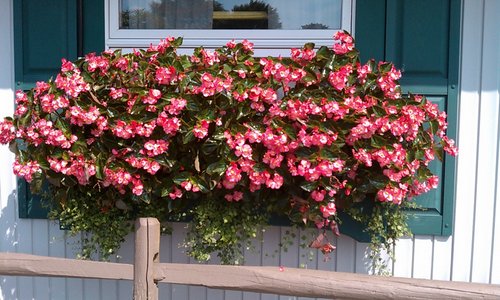 Rice. 8 Flowers on the loggia - begonia
Rice. 8 Flowers on the loggia - begonia
The soil for begonias is fertile with a slightly acidic reaction. Watering is required frequently, especially in hot weather. Begonia loves wet soil.
Perfectly decorate a shady balcony - fuchsia. It blooms profusely. The color of flowers is very different. The ampelous options for fuchsia look especially impressive, which hang from the pots in an exuberant flow of flowers. Fuchsia reproduces simply, but grows quickly.
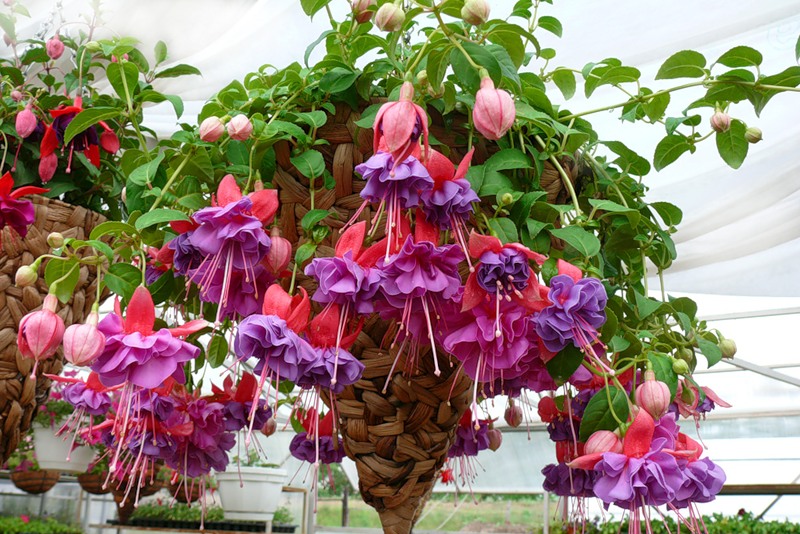 Rice. 9 Ampel flowers for the balcony - fuchsia
Rice. 9 Ampel flowers for the balcony - fuchsia
Verbena, forget-me-nots, carnations and levkoi will grow well in the shade. If a strong wind is likely, it is better to stay on low-growing plants. These can be daisies, marigolds and some others.
 Rice. 10 Balcony flowers - carnations
Rice. 10 Balcony flowers - carnations
If the loggia is not glazed, then the floral design is possible only in the summer. In order for the plants to be grown all year round, the space needs to be insulated.
Having glazed and insulated the balcony, we get a place where you can put a flower planted in cold weather. Flowers on the glassed-in balcony create an interesting design and spring mood.
Boxes for balcony flowers and plants
The boxes as the basis of the garden composition should be the same size. Green shoots will look brighter if the color of the balcony finish does not "interrupt" the color scheme formed by the plants. An important advantage of homemade containers for planting flowers is the development of such sizes that increase the mobility of structures, that is, carrying boxes is not difficult for one person.
It is necessary to drill holes in the bottom for drainage, to lay small fragments of bricks or sea stones on the bottom to prevent soil or special planting mixture from spilling out. Next, you need to lay a layer of sand or peat to retain the optimal amount of moisture.
 Use specialized ground for balcony flowers.
Use specialized ground for balcony flowers.
Growers strive to achieve near-constant flowering in portable greenhouses. To do this, it is necessary to carry out a certain scientific and educational work: to study the literature, compare color images of plants, choose the most suitable in terms of the timing and duration of flowering.
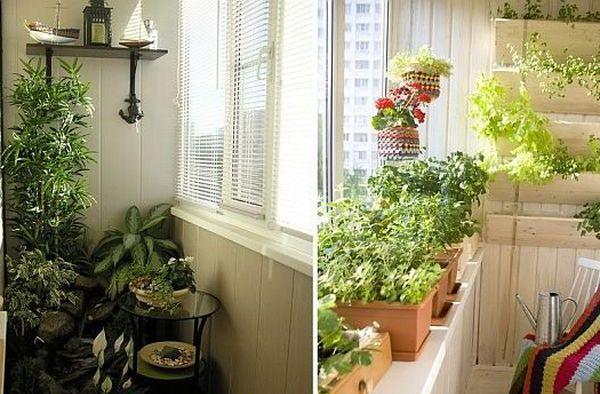
Which flowers are best for the balcony - garden or indoor
On the loggia or balcony, you can successfully grow both indoor and garden flowers. But there are several fundamental points here.
You can grow indoor plants on the balcony during the warm season, and all year round. An open space without glazing or a glazed but not insulated room is suitable for seasonal gardening. In this case, indoor flowers can be taken out there not earlier than the end of April-beginning of May (for central Russia), and this should be done gradually. Start at two o'clock in the morning, gradually increasing the time the plants are in the sun and at a different temperature regime.
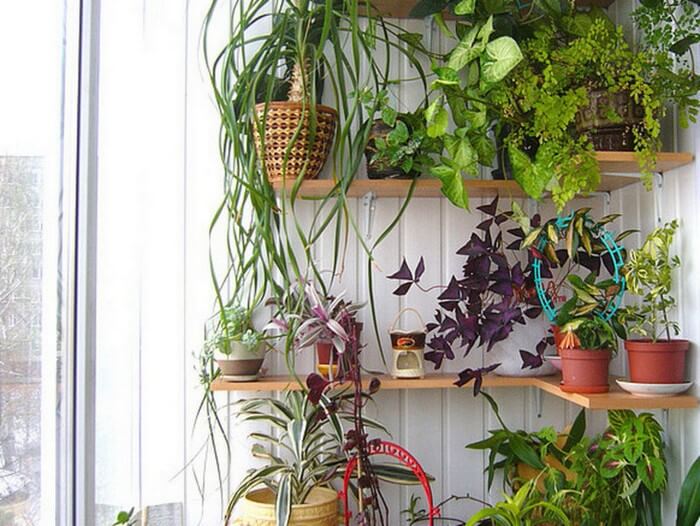
Indoor species will not survive winter outdoors. You will have to well insulate the balcony under the flowers or bring them into the house during the cold period, creating a comfortable microclimate there.
The first option is not always affordable, and the second is not always convenient. Think carefully before equipping a luxurious garden with only indoor plants on your balcony.
Garden species are more resistant to weather conditions and temperature fluctuations. However, not many of them can grow in limited soil conditions.Most of these are annuals. Good examples are petunias, marigolds, lobelia, pansies.
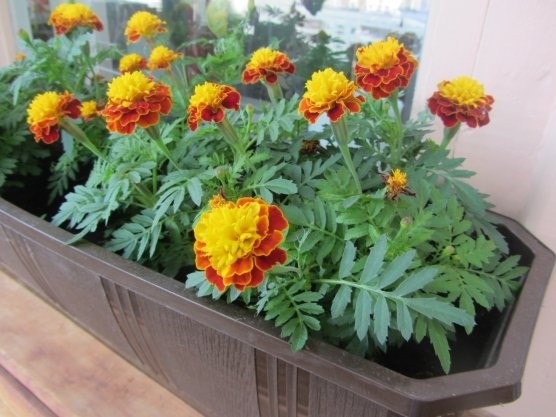
Marigolds bloom profusely all summer
Types of landscaping balconies and loggias
To create a home garden, various planting options are used. At the same time, different planting methods can be connected with each other, which will give a special originality to the home garden on the balcony.
One of the ways to decorate a balcony is horizontal landscaping. With such landscaping, the emphasis is on horizontal lines. To decorate your balcony in this way, you need to arrange pots with various plants and flowers around the perimeter. The pots can be installed on special shelves or racks with flower stands. An excellent option would be to install a plank along the entire length of the window. Further, vases or flower boxes are placed on the bar and plants are planted there.
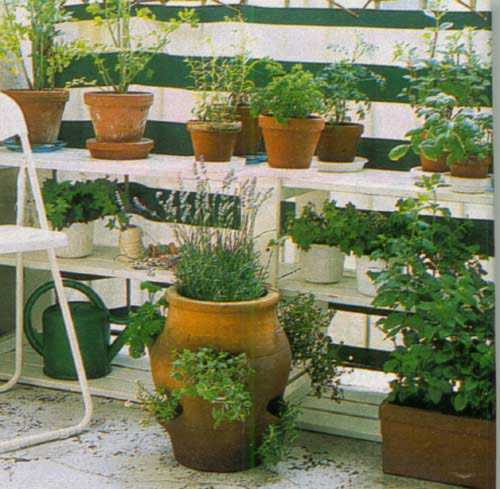 Horizontal landscaping is suitable for large and wide balconies and loggias
Horizontal landscaping is suitable for large and wide balconies and loggias
Vertical gardening is also widely used. For this method, the wall is completely used. Plants with long-growing stems twisting among themselves are recommended. As with horizontal gardening, racks or stands are placed along the wall, and pots of flowers are placed directly there. Flowers such as liana, hoya, ivy and the like will look gorgeous. Flower pots can be easily replaced with a tall rack with existing planting spots, or you can install flower pots on specially installed shelves.
 Vertical gardening of the balcony is usually preferred by the owners of small balconies and narrow loggias.
Vertical gardening of the balcony is usually preferred by the owners of small balconies and narrow loggias.
Phytowalls are especially popular. This is a relatively new and modern interior design. Fitostena is essentially a structure that provides for an automatic watering and lighting system. Flowers are planted in pots with peat, without adding soil. The result is a solid flower wall. Due to its compactness, autowatering system and beauty, phytowall is becoming very popular for decorating premises.
 Fitowall on the balcony is a new trend in balconies and loggias landscaping.
Fitowall on the balcony is a new trend in balconies and loggias landscaping.
Designers love to combine different types of landscaping. This is how they combine both horizontal and vertical landscaping. And the phytowall is combined with large shelves in the same compositions. This creates a harmonious space.
The most unpretentious balcony flowers
Any florist would like to take care of the plants on the balcony to a minimum and at the same time admire their long and lush flowering. Fortunately, there are types of flowers that meet all these requirements.
5 most popular unpretentious plants:
- Marigold. These flowers are known to everyone. The abundance of varieties allows you to choose plants with very different colors (yellow, orange, red, variegated) and the degree of double petals. When planting on the balcony, only low-growing species, whose height does not exceed 15-25 cm, will look beautiful. Some hybrid marigolds grow in the form of a bush. It will be enough to plant 1–2 plants in a box, in the future they grow strongly. The flowering of marigolds begins in early summer and continues until frost. In order for the plants to always look decorative, it is necessary to remove faded buds in a timely manner.
- Pelargonium. The popular name for this plant is geranium. The flower grows well, blooms magnificently all summer, has a spicy scent. Classic color options - red and white, more modern varieties have a wide range of colors up to maroon, almost black. For the winter, the flower can be transferred to the house, where it will continue to bloom. Geranium is great for creating compositions. Florists recommend combining it with evening primrose, bacopa, immortelle, petunias.
- Nemesia. Low compact bushes perfectly decorate the balcony. For a more lush flowering, young seedlings are pinched after planting.Flowers are planted in a box at intervals of 20 cm. The colors of nemesia can be monochromatic, two-color and three-color. The heat will shorten the flowering time. Nemesia can bloom in 2 waves. To get flowers again closer to autumn, the stems are shortened after the first wave of flowering.
- Fuchsia. To plant these flowers on the balcony in boxes, it is better to choose ampelous plant varieties. The flower is unpretentious, easily put up with shade. Cascading blossoming buds look very impressive and eye-catching. The length of fuchsia shoots can be up to 50 cm. The color of the flowers is most often red and white. The only important condition for growing fuchsias is regular and abundant watering. After a drought, the flower will no longer recover.
- Pansies (Viola). Plant height is only 15-25 cm. There are many hybrid varieties. If the flowers are regularly watered and shaded from the midday sun, they will delight the eye with their beauty for a long time. For lush flowering, plants also need feeding. Viola's coloring is very cheerful, combining two contrasting colors (usually yellow-violet). Flowering continues throughout the summer.
A good start is important for annuals, so you need to properly care for the seedlings. If quality seeds were used, and the seedlings received everything they needed, then the flowers will grow healthy, strong. Only such plants will be able to bloom beautifully.
What to plant on the shady balcony?
The balconies located on the north side of the building are called shady. Shade-tolerant annuals are usually planted here, which tolerate cool air and cold winds well. Sometimes the balconies on the south or west side also turn out to be shaded, for example, if tall trees grow near the house. What to plant from flowers in this case?
Top 5 plants that will do well in the shade:
- Lobelia. The culture can grow both in the sun (with shading) and in the shade. The plant easily tolerates high humidity, cold, lack of fertilizing. This species belongs to the family of bell-flowers and blooms with delicate small flowers of white, crimson cornflower-blue color. There are bush and curly varieties of lobelia. The flower is grown through seedlings, and at the end of May, transplanted into balcony boxes. To stimulate a new wave of flowering, you need to prune the shoots of the bushes. Blossoming lobelias become a real decoration for the balcony.
- Nemophila. This flower is called American forget-me-not. Nemophila compensates for its modest beauty by the absence of increased requirements for care. Most often, the flowers are bluish in color with a white center. Their size in diameter is only 1 cm, the height of an annual can vary from 15 to 30 cm. Since nemophila is resistant to cold, it can be planted on the balcony as early as May. The plant grows well in containers. Nemophila is demanding only for watering (does not like both dryness and waterlogging). American forget-me-not blooms profusely from mid-July until the first frost.
- Ageratum. The plant is suitable for shaded balconies where there are no too strong winds. The flower is thermophilic; it is better to plant it in the open air at a temperature of at least 20 ° C. You can sow seeds in advance or plant purchased seedlings. This is a perennial plant and can be brought into the house for the winter. Flowering continues even in the cold season. Most often, the color of the flowers is blue, lilac, white. Ageratum blooms with dense caps. Depending on the variety, the height of the bushes ranges from 10 to 50 cm.
- Ever-flowering begonia. This kind of begonia blooms for a long time, tolerates shading well, loves moist air. She will love the north balcony in shaded conditions. There will not be many flowers, but the opened buds look charming. Begonia is unpretentious in care.
- Primrose. The plant is perennial, for the winter it is brought into the house if the balcony is not heated. Primrose flowers are very bright and delicate at the same time.The plant is fond of shade. Flowering continues until the end of summer. It is necessary to regularly loosen the soil in the pot and water the flower. Complex fertilizers can be used for feeding several times a season.
For the normal development of shade-loving plants, it is enough to get diffused color 3-4 hours a day. In the bright sun, their petals often fade, and the foliage becomes faded. The same group includes balsams, mimulus, calendula, calceolaria.
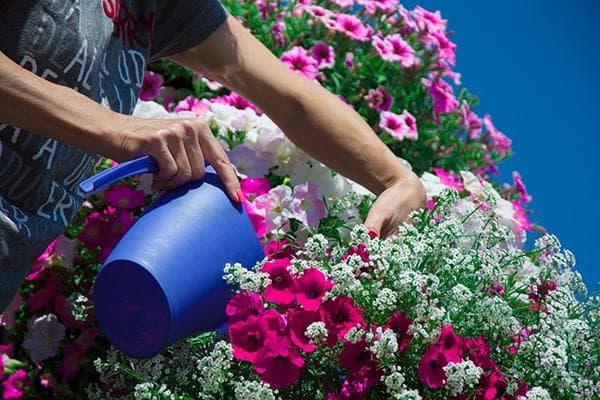
Blooming walls in hydroponics
On the balconies, you can also use various methods of growing plants not using the traditional method - not in the soil, but in special substrates that hold nutrient solutions.
Growing without soil allows not only to make the process "cleaner", to reduce the real load on the balcony structure, but also opens up new perspectives in care: after all, such plants, as a rule, do not require such complex care. On the balcony, hydroponics and self-irrigated containers are used both for ordinary plants and for finding new ideas in the design of vertical elements.
For vertical gardening of balconies, you can use several options for hydroponic "walls":
- vertical walls of moss with hanging gardens laid out on them;
- the use of a bag or a suspended soft wall, a "canvas" with sewn pockets in which plants are planted (usually their base is made of waterproof durable fabrics - tarpaulin, burlap with complex impregnation);
- planting plants in plastic pipes with holes;
- creation of a vertical garden in pallets (pallets) converted into a "wall";
- planting plants in converted tubs, cans and drums with drilled holes for planting plants.
 You can create a vertical hydroponic garden in pallets (pallets) converted into a “wall”. Aha
You can create a vertical hydroponic garden in pallets (pallets) converted into a “wall”. Aha
Organization of vertical structures in hydroponics
The most perfect type of flowering walls on balconies are structures that migrated to balconies from interiors (phytowalls). This is a special narrow design with an automatic irrigation system, and often with supplementary lighting, in which plants are planted in clean peat or ion exchange substrate.
The essence of all such walls is the same: a base (structure) is selected or altered, which will hold the moisture-absorbing substrate in an upright position, with holes or pockets for planting plants. In fact, this is a balcony version of vertical beds and strawberry gardens. Sometimes the space is lined with foil as an insulating layer.
Any base is suitable, in which holes with a diameter of 4-5 cm are located at a distance of about 15-20 cm. At the bottom of the wall, container, pipe, there should be a hole for water drainage. The structure is filled in the same way as any container - from the drainage layer at the bottom to the complete filling of the space with the selected filler substrate and the installation of capillaries, conductors for an aqueous nutrient solution - thin tubes or branches that will help maintain high water permeability. The addition of hydrogel and loosening admixtures is only welcome.
For vertical walls on the balcony, ion-exchange soil, expanded clay, coconut fiber, peat are used. But moss is still the best choice, especially for hot balconies. As a filler, it not only provides a much more efficient moisture retention, but also protects the plants from overheating. The main requirements for the filler are the combination of coarse texture with large particles, the ability to retain water, resistance to any decay and rot, neutral reaction and non-toxicity.
Growing flowering walls according to the principle of hydroponic installations is possible only when using nutrient solutions for hydroponic crops. Strictly following the manufacturer's instructions for concentration and frequency of treatments, hydroponic solutions are applied less frequently than watered and fed conventional crops.
Both annuals and perennials can be used to create flowering balcony walls using the hydroponic method. The main thing is that the selected species bush densely, be able to grow, create a continuous cover, or develop in the form of compact, but curly bushes. Periwinkles and anemones, marigolds, pansies, verbena, alissum, begonias, gamolepis, carnations, godetia, ivy, lobelia, balsams, armeria and all types of annual ampelous plants are planted in such walls.
What indoor plants can be taken out in the summer to the north balcony
You can also decorate the northern balcony with indoor plants. This “rest” helps the flowers grow healthy and make it easier to survive the winter. True, not everyone will like such a move. But there are flowers that will gratefully respond to such care. Among them:
- aucuba;
- euonymus;
- washingtonia;
- dieffenbachia;
- clivia;
- myrtle;
- monstera;
- nightshade;
- ivy;
- tradescantia;
- ficus;
- chlorophytum;
- yucca.
Keep plants on the balcony for days only when the difference between day and night temperatures becomes minimal. It is better to do this from the end of May, when the air is finally warmed up. If the balcony or loggia is glazed, flowers can be brought out earlier - in March-April. But at night it is better to bring it into the house.
Gradually accustom your indoor plants to the open air. Take them out in the morning for a few hours, and then increase the time. So you can be sure that the flowers will harden and will not get sick from hypothermia.
The Uzambara violet (Saintpaulia) does not like temperature changes, so it is better not to take it out to the balcony.

